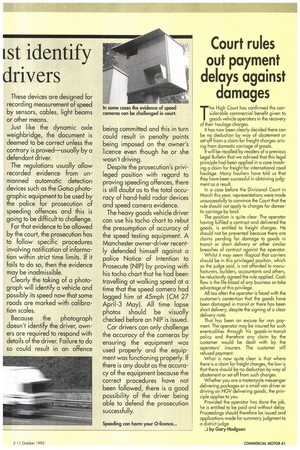Operators speedii
Page 42

Page 43

If you've noticed an error in this article please click here to report it so we can fix it.
It doesn't matter if they're behind the wheel of a 38-tonner or the family saloon car; some drivers seem to be addicted to breaking speed limits.
No doubt regular offenders rely on the fact that they cannot be successfully prosecuted without some corroborative evidence of the police officer's observations such as mechanical devices including police vehicle speedometers or radar equipment. However, the prosecution does not have to produce any evidence as to accuracy of the mechanical devices it relies upon, despite a number of cases where defendant drivers have raised doubts as to their accuracy.
The record produced by these prescribed devices together with a certificate signed by the officer outlining the circumstances as to how the record was produced and a belief that it is accurate is usually sufficient.
The prescribed devices are given evidential status by virtue of the Road Traffic Offenders Act 1988 Section 20 as subsequently amended in 1991 by the 1991 Road Traffic Act. These devices are designed for recording measurement of speed by sensors, cables, light beams or other means.
Just like the dynamic axle weighbridge, the document is deemed to be correct unless the contrary is proved—usually by a defendant driver.
The regulations usually allow recorded evidence from unmanned automatic detection devices such as the Gatso photographic equipment to be used by the police for prosecution of speeding offences and this is going to be difficult to challenge.
For that evidence to be allowed by the court, the prosecution has to follow specific procedures involving notification of information within strict time limits. If it fails to do so, then the evidence may be inadmissible.
Clearly the taking of a photograph will identify a vehicle and possibly its speed now that some roads are marked with calibration scales.
Because the photograph doesn't identify the driver, owners are required to respond with details of the driver. Failure to do so could result in an offence being committed and this in turn could result in penalty points being imposed on the owner's licence even though he or she wasn't driving.
Despite the prosecution's privileged position with regard to proving speeding offences, there is still doubt as to the total accuracy of hand-held radar devices and speed camera evidence.
The heavy goods vehicle driver can use his tacho chart to rebut the presumption of accuracy of the speed testing equipment. A Manchester owner-driver recently defended himself against a police Notice of Intention to Prosecute (NIP) by proving with his tacho chart that he had been travelling at walking speed at a time that the speed camera had logged him at 45mph (CM 27 April-3 May). All time lapse photos should be visually checked before an NIP is issued.
Car drivers can only challenge the accuracy of the cameras by ensuring the equipment was used properly and the equipment was functioning properly. If there is any doubt as the accuracy of the equipment because the correct procedures have not been followed, there is a good possibility of the driver being able to defend the prosecution successfully.
Speeding can harm your 0-licence...




































































































































